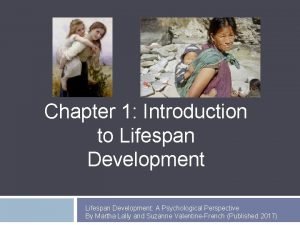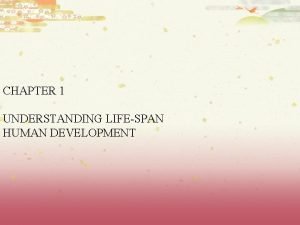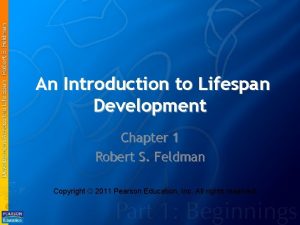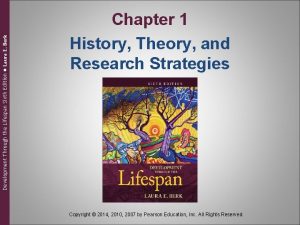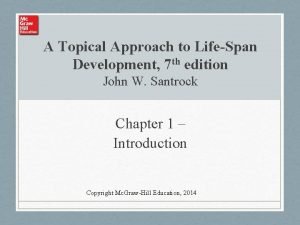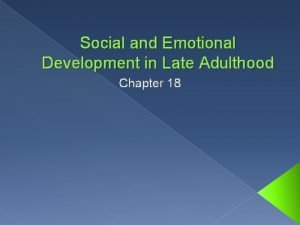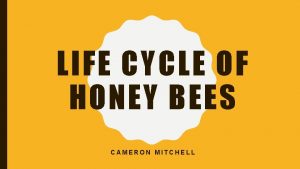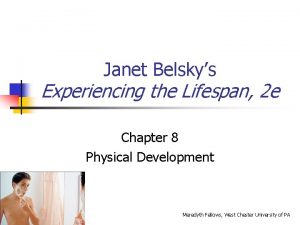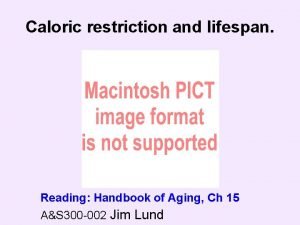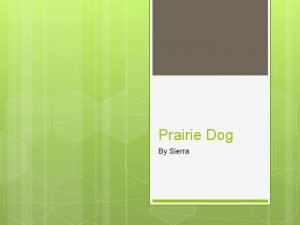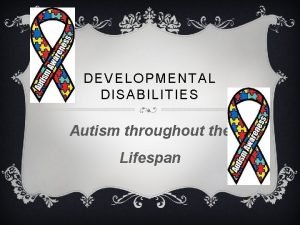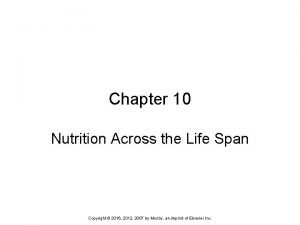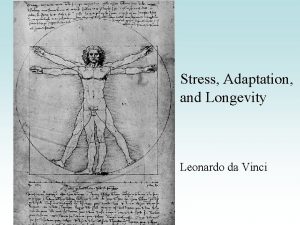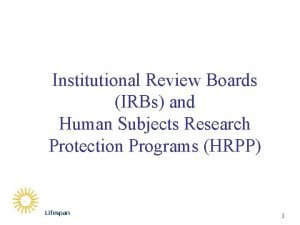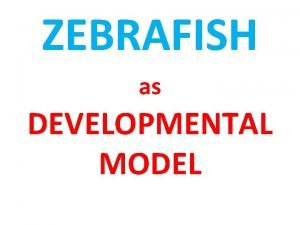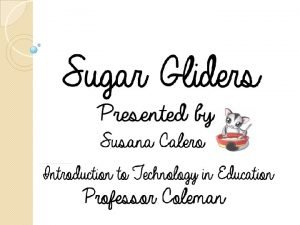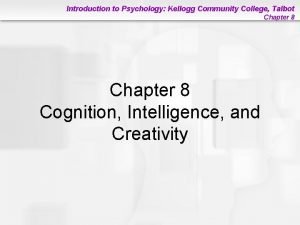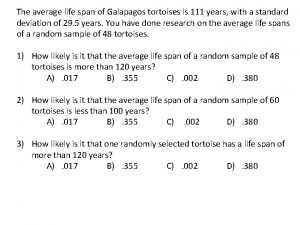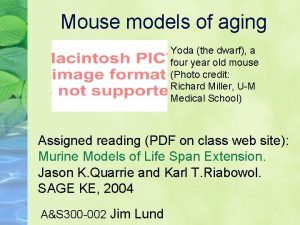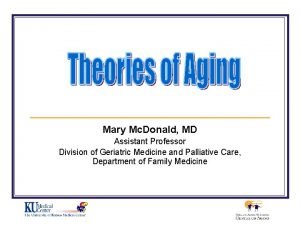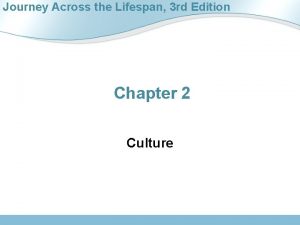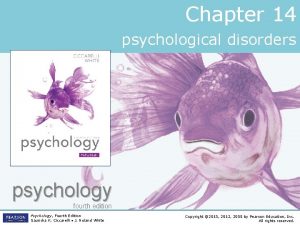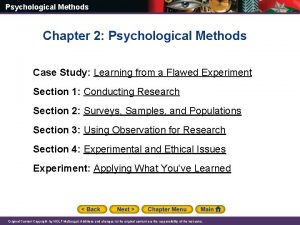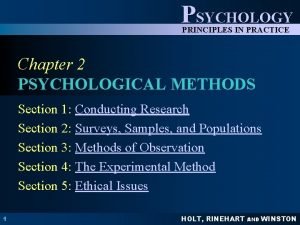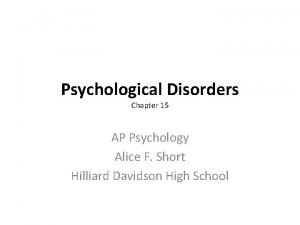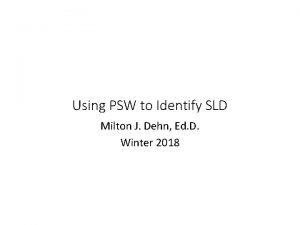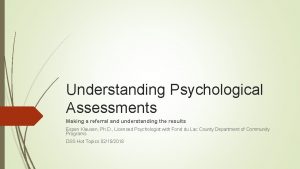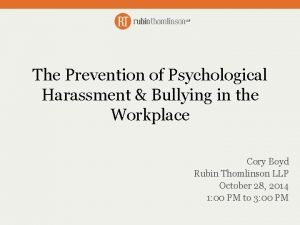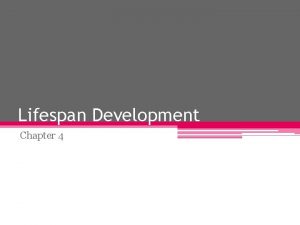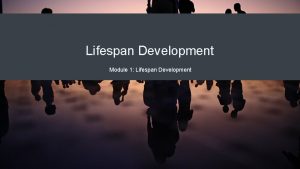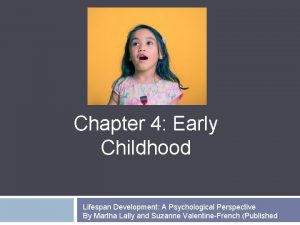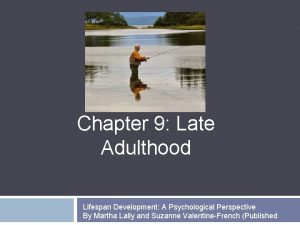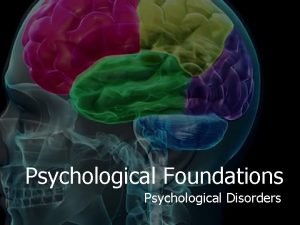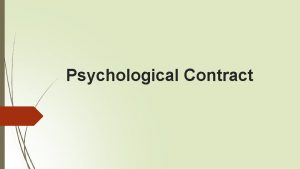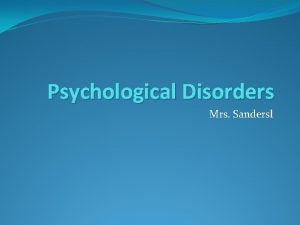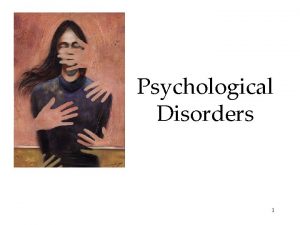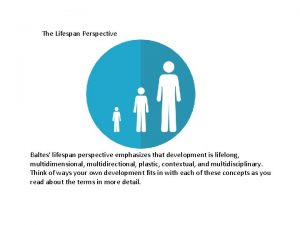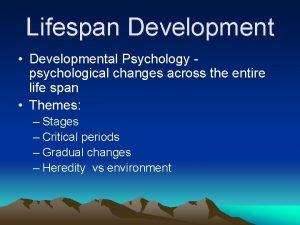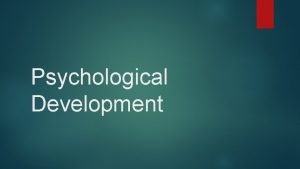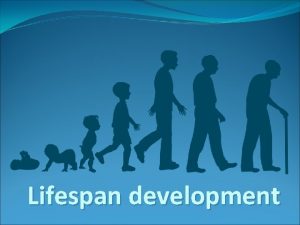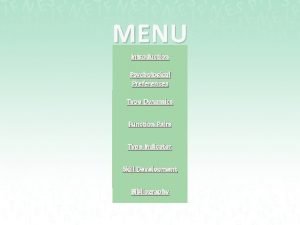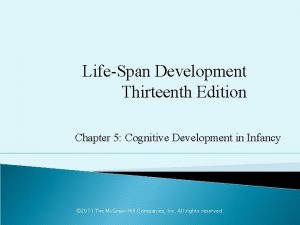Chapter 1 Introduction to Lifespan Development A Psychological


















































- Slides: 50

Chapter 1: Introduction to Lifespan Development: A Psychological Perspective By Martha Lally and Suzanne Valentine-French (Published 2017)

In this chapter: The lifespan perspective � Periods of development � Theories of development Research methods and issues � Types of research studies � Ethical issues

What is developmental psychology? Scientific study of how people change � Multiple areas (cognition, emotional control, etc. ) � Also concerned with what causes changes � May focus on specific age group or entire lifespan � May also look at how people don’t change

Key questions Qualitative or quantitative differences? � Do children think differently than adults or just have less knowledge? Continuous or discontinuous? � Is change gradual or marked by distinct stages? Nature or nurture? � Is development innate or affected by experience?

Learning objectives: The lifespan perspective Explain the lifespan perspective and its assumptions about development Differentiate periods of human development Explain the issues underlying lifespan development Identify the historical and contemporary theories impacting lifespan development

The lifespan perspective (Baltes, 1987) Development is lifelong � No one age period is more important than another Development is multidirectional � Includes both gains and losses Development is multidimensional � Physical – Body growth, immune function, motor skills � Cognitive – Attention, memory, language, intelligence � Psychosocial – Self-perception, relationships

The lifespan perspective (Baltes, 1987) (continued) Development is multidisciplinary � Involves fields such as biology, sociology, and medicine Development is characterized by plasticity � Plasticity – Many of our characteristics are malleable and can be changed Development is multicontextual � Affected by circumstances such as time and socioeconomic status

Contexts of development (Baltes, 1987) Normative age-graded influences � Changes experienced by people in a certain age group (e. g. , learning to talk, puberty, retirement) Normative history-graded influences � Changes experienced by people alive at a certain time (e. g. , war, epidemics, economic recession) � Cohort - A group of people born at roughly the same period in a particular society Non-normative life influences � Individual lottery) experiences (e. g. , illness, winning the

Table 1. 1 Which generation (cohort) are you? Generation Born between … Silent Generation 1928 and 1945 Baby Boomers 1946 and 1964 Generation X 1965 and 1980 Millennials 1980 and later

Socioeconomic status Identifier based on shared levels of education, income, and occupation People of similar SES are often similar in other ways (e. g. , parenting styles, where they live, stressors) Higher SES associated with more control and less stress Lower SES associated with poorer health and lower life expectancy due to poor diet, dangerous jobs, lack of medical care, etc.

Culture Totality of shared language, knowledge, material objects, and behavior � Ideas about right and wrong � Social interaction behaviors � Food, music, and activity preferences � Beliefs about achievement and success Culture is learned from the people around us Helps members function in their society

Culture (continued) Ethnocentrism – Belief that one’s own culture is superior to other cultures Cultural relativity � Appreciation for cultural differences � Understanding that cultural practices are best understood from the standpoint of that particular culture

Lifespan vs. life expectancy Lifespan (longevity) � The length of time a species can exist under the most optimal conditions � Species-specific Life expectancy � Predicted number of years a person born in a particular time period can reasonably expect to live � Affected by behavior, experiences, individual genetic factors

Conceptions of age Chronological age - The number of years since your birth Biological age – How quickly your body is aging Psychological age – Psychologically adaptive capacity compared to others of our chronological age Social age - Based on the social norms of our culture and the expectations our culture has for people of our age group

Periods of development Prenatal – Conception to birth Infancy and toddlerhood – Birth to 2 years of age Early childhood – 2 to 6 years of age Middle childhood – 6 years of age to puberty Adolescence – From onset of puberty to age 18 Emerging adulthood – 18 to 25 years of age Early adulthood – 25 to 40 or 45 years of age Middle adulthood – 40 -45 to 60 -65 years of age Late adulthood – Age 65 and older

Table 1. 2 Age periods of development Age Period Prenatal Infancy and Toddlerhood Early Childhood Middle and Late Childhood Adolescence Emerging Adulthood Early Adulthood Middle Adulthood Late Adulthood Description Starts at conception, continues through implantation in the uterine wall by the embryo, and ends at birth. Starts at birth and continues to two years of age Starts at two years of age until six years of age Starts at six years of age and continues until the onset of puberty Starts at the onset of puberty until 18 Starts at 18 until 25 Starts at 25 until 40 -45 Starts at 40 -45 until 60 -65 Starts at 65 onward

Issues in development: Nature and nurture Question about causes of development – Why are we the way we are? � Nature perspective - Heredity plays the most important role in causing a trait/behavior � Nurture perspective – The environment is most significant in shaping the way we are Many things are caused by interaction of nature and nurture

Issues in development: Continuity vs. discontinuity Question about the course of development – Gradual process or abrupt change? Continuous � Development is a slow and gradual process Discontinuous � Developmental change often occurs in distinct stages � Stages are qualitatively different from each other � Stages occur in a set, universal sequence

Figure 1. 6 Continuous and discontinuous development The tree represents continuous development, while the ladybug represents discontinuous/stage development

Issues in development: Active vs. passive How much of a role do we play in our development? Active – We construct our experiences Passive – We are affected by the environment or our genes with little control

Issues in development: Stability vs. change How much do we change as we develop? In what ways do we change? Stability perspective – We change very little from childhood to adulthood Change perspective – Initial tendencies modified by experiences

Historical theories of development Preformationism - A tiny, fully formed human is implanted in the sperm or egg at conception and then grows in size until birth � Assumes infants are born with all capabilities intact � Environment plays no role in development

Historical theories of development (continued) Tabula rasa (blank slate) – John Locke � Child’s mind entirely shaped by environment � Early experiences important Jean-Jacques Rousseau’s theory � Development occurs on biological timetable � Children should be allowed to develop naturally

Historical theories of development (continued) Maturational theory – Arnold Gesell � Development activated by genes � Development occurred in fixed sequences Freud’s psychosexual theory � Must learn to transform biological instincts into socially acceptable behaviors � Early experiences important

Contemporary theories of development Erikson’s psychosocial theory � Each period of life has a unique challenge (psychosocial crisis) that must be managed � Resolution of early crises may affect later crises Learning theory (behaviorism) � Psychology should focus on observable behavior � Environment is important for affecting development

Table 1. 3 Erikson’s psychosocial stages Age range Birth to 12 to 18 months to 3 years 3 to 6 years Psychosocial crisis Trust versus Mistrust 6 to 12 years Industry versus inferiority Identity versus role confusion Intimacy versus isolation Generativity versus stagnation 12 to 18 years 19 to 40 years 40 to 65 years 65 to death Autonomy versus shame/doubt Initiative versus Guilt Ego integrity versus despair Positive resolution of crisis The child develops a feeling of trust in his or her caregivers. The child learns what he or she can and cannot control and develops a sense of free will. The child learns to become independent by exploring, manipulating, and taking action. The child learns to do things well or correctly according to standards set by others, particularly in school. The adolescent develops a well-defined and positive sense of self in relationship to others. The person develops the ability to give and receive love and to make long-term commitments. The person develops an interest in guiding the development of the next generation, often by becoming a parent. The person develops acceptance of his or her life as it was lived.

Contemporary theories of development (continued) Social learning theory � We learn through observation and imitation (Bobo doll video) � Reciprocal determinism – We influence the environment and vice versa

Contemporary theories of development (continued) Piaget’s cognitive theory � Children of different ages interpret the world differently � Changes caused by maturation, not training Vygotsky’s sociocultural theory � Culture and social interaction influence cognitive development � Can increase performance with proper guidance

Table 1. 4 Piaget’s stages of cognitive development Stage Sensorimotor Approximate age range Birth to about 2 years Preoperational 2 to 7 years Concrete operational 7 to 11 years Formal operational 11 years to adulthood Characteristics Stage attainments The child experiences the world through the fundamental senses of seeing, hearing, touching, and tasting. Children acquire the ability to internally represent the world through language and mental imagery. They also start to see the world from other people’s perspectives. Children become able to think logically. They can increasingly perform operations on objects that are real. Adolescents can think systematically, can reason about abstract concepts, and can understand ethics and scientific Object permanence Theory of mind; rapid increase in language ability Conservation Abstract logic

Contemporary theories of development (continued) Information processing theory � Cognitive development is continuous � We’re born with the ability to notice stimuli, store, and retrieve information � Brain maturation and experiences develop our information processing system

Contemporary theories of development (continued) Bronfenbrenner’s ecological systems theory – Individuals function in and are impacted by systems � Microsystem – Immediate settings and people � Mesosystem – Organizational structures (e. g. , school, religion) that affect microsystem � Exosystem – Community’s values, history, and economy � Macrosystem – Influence of culture � Chronosystem – Influence of time

Figure 1. 11 Bronfenbrenner’s ecological systems theory

Learning objectives: Research methods Define the scientific method Compare research methods noting the advantages and disadvantages of each. Explain research involving time spans Explain ways to conduct ethical research

Research methods: Terms Scientific method - The assumptions, rules, and procedures scientists use to conduct research Research design – The specific way a researcher collects, analyzes, and interprets data � Descriptive research describes what is occurring at a particular point in time � Correlational research examines relationships among variables � Experimental research involves manipulating variables to see their effects

Types of descriptive research Case study – Describe experience of individual or small group Naturalistic observation – Observe and record behavior in everyday settings Laboratory observation – Observe behavior in a setting created by the researcher

Types of descriptive research (continued) Survey – Verbal or written questionnaire � Sample – Group who participates in the study � Population – Larger group the sample is based on � A representative sample includes the same percentages of genders, age groups, ethnic groups, and socio-economic groups as the larger population � Social desirability – Participants might lie to make themselves look good

Types of descriptive research (continued) Interview – Direct questioning by researcher Psychophysiological assessment – Biological measures (e. g. , heart rate, hormone levels, brain activity) Secondary/Content analysis – Examine information already collected (e. g. , media, existing data sets)

Correlational research Assesses relationship between two or more variables Does not show causation � May not know direction of relationship TV violence causes aggression? Or aggressive kids watch more violent TV? � Third variable may produce relationship Parenting style may affect both aggression and TV viewing

Correlational research (continued) Pearson correlation coefficient – Most common statistical measure � Ranges from -1 to 1 � Strength indicated by distance from 0 Closer to 0 = Weaker Farther from 0 = Stronger � Direction indicated by valence Positive = Both variables change in same direction Negative = Variables change in opposite directions

Figure 1. 14 Examples of scatter plots

Figure 1. 15 Illustration of third variable influence

Experimental method Studies cause-and-effect relationships Tests hypotheses – Specific statements about the relationships between variables � Variable = Something that changes in value � Independent variable Causal variable Manipulated/controlled by researcher � Dependent variable Measured (outcome) variable Believed to be affected by IV

Experimental method (continued) Participants randomly assigned to groups � Each group receives different level of IV Experimental group receives treatment Control group doesn’t � Compare each group on outcome (DV) Different outcomes caused by differences in IV Control for extraneous variables � Variables that could affect results but aren’t part of experiment

Table 1. 5 Characteristics of the three research designs Research design Descriptive Goal To create a snapshot of the current state of affairs Correlational To assess the relationships between and among two or more variables Experimental To assess the causal impact of one or more experimental manipulations on a dependent variable Advantages Provides a relatively complete picture of what is occurring at a given time. Allows the development of questions for further study. Allows testing of expected relationships between and among variables and the making of predictions. Can assess these relationships in everyday life events. Allows drawing of conclusions about the causal relationships among variables. Source: Stangor, C. (2011). Research methods for the behavioral sciences (4 th ed. ). Mountain View, CA: Cengage. Disadvantages Does not assess relationships among variables. May be unethical if participants do not know they are being observed. Cannot be used to draw inferences about the causal relationships between and among the variables. Cannot experimentally manipulate many important variables. May be expensive and time consuming.

Developmental research Cross-sectional research � Compare different groups that vary in age � Cohort effect – Age differences caused by being born in a certain time period Differences in attitudes, experiences, education

Developmental research (continued) Longitudinal research � Study one group repeatedly over time � Attrition – People stop participating � Practice effect – Performance improves with practice

Developmental research (continued) Sequential research � Study multiple age groups over time

Table 1. 6 Time span research designs advantages and disadvantages

Ethics in research Prevent harm to participants Informed consent � Participants must understand what they’ll be asked to do and why � Some deception may be allowed � Children ineligible to give informed consent

Ethics in research (continued) Confidentiality Deception - Participants are not fully informed about the nature of the research project before participating in it Debriefing - Explain the purposes and procedures of the research and remove any harmful aftereffects
 Lifespan development a psychological perspective
Lifespan development a psychological perspective Physical development
Physical development Chapter 9 lifespan development
Chapter 9 lifespan development Exploring lifespan development chapter 1
Exploring lifespan development chapter 1 Exploring lifespan development chapter 1
Exploring lifespan development chapter 1 Development through the lifespan 6th edition
Development through the lifespan 6th edition A topical approach to lifespan development
A topical approach to lifespan development Guidance counselling and lifespan development
Guidance counselling and lifespan development Lifespan development third edition
Lifespan development third edition Lifespan development third edition
Lifespan development third edition Robert peck's stages of psychological development
Robert peck's stages of psychological development Lifespan of a snow leopard
Lifespan of a snow leopard Gulper eel lifespan
Gulper eel lifespan Display caramelized petit fours
Display caramelized petit fours Splendour beetle lifespan
Splendour beetle lifespan Life span of honey bee
Life span of honey bee Juan ponce de leon lifespan
Juan ponce de leon lifespan Nn teens
Nn teens Henry hudson lifespan
Henry hudson lifespan Lifespan of every animal
Lifespan of every animal The developing person through the life span 9th edition
The developing person through the life span 9th edition Prairie dog lifespan
Prairie dog lifespan Autism lifespan
Autism lifespan Chapter 10 nutrition
Chapter 10 nutrition Life span of eagle
Life span of eagle Da vinci lifespan
Da vinci lifespan Lifespan irb
Lifespan irb Henry hudson lifespan
Henry hudson lifespan Portuguese man of war habitat
Portuguese man of war habitat Lifespan of platelets
Lifespan of platelets Nudibranch scientific name
Nudibranch scientific name Life cycle of zebrafish
Life cycle of zebrafish Sugar glider lifespan
Sugar glider lifespan Concept formation in psychology
Concept formation in psychology Galapagos turtle lifespan
Galapagos turtle lifespan Yoda lifespan
Yoda lifespan Mary quiceno md
Mary quiceno md Journey across the lifespan
Journey across the lifespan Biosphere definition biology
Biosphere definition biology Chapter 18 psychological disorders review worksheet
Chapter 18 psychological disorders review worksheet Chapter 18 psychological disorders
Chapter 18 psychological disorders Chapter 14 psychological disorders
Chapter 14 psychological disorders Chapter 2 psychological methods
Chapter 2 psychological methods Psychology chapter 2 section 1
Psychology chapter 2 section 1 Chapter 14 psychological disorders
Chapter 14 psychological disorders Ap psychology chapter 15 psychological disorders
Ap psychology chapter 15 psychological disorders Dehn psw model
Dehn psw model Referral question example
Referral question example Very superior intelligence
Very superior intelligence Marsh et al
Marsh et al Linear and transactional model of communication
Linear and transactional model of communication
